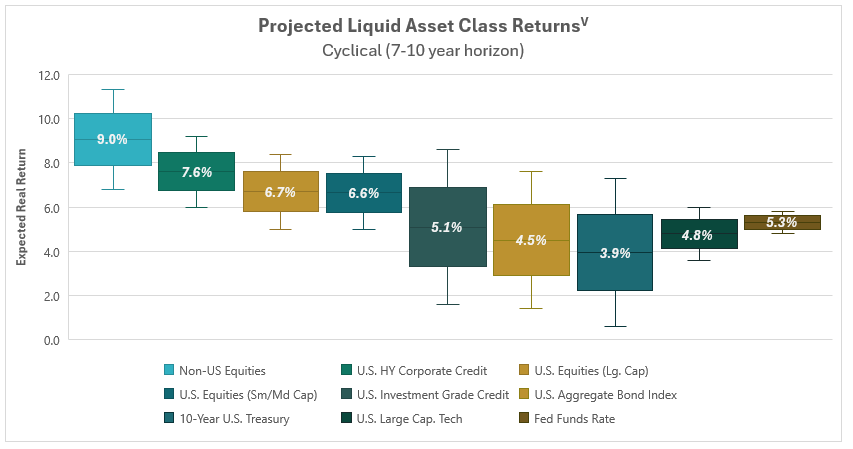“Trying to predict the direction of the market over one year, or even two years is impossible.”
- Peter Lynch
It is January and the time of the year that a myriad of practitioners put out their forecasts for the market and the key indicators that drive the overall economy. Despite the unenviable record of market predictions, investment practitioners keep doing it, particularly when industry peers take the lead and put out the first forecasts. As our clients are aware, we at Trajan Wealth are not in the business of predicting the markets; our process, by contrast, involves looking at what is being “priced in” given the level of asset prices – call this a “risk premium,” and the risks to the implied returns given our understanding of the underlying assets. Thus, our outlook should not be interpreted as the rate of return we predict to earn for the next year or two – rather an estimate of the risk premium we expect to earn if the assets are held over the course of a market cycle. Given that there is risk to our “median” estimate, we highlight a range of returns over asset classes that should capture the bulk of probable future outcomes. While the “median” estimate is quantitative and scientific, we take the liberty of a certain amount of judgment – or “art” when postulating the range of outcomes.
Public Equities
With valuations in the US equity markets higher than long-term averages, “risk premiums” or expected returns are low by historical standards – see column marked “Earnings Yield” in the table below. The US Treasury market is pricing inflation to average 2.3% over the next decade, slightly higher than the US Federal Reserve Bank’s 2% target. As such, we expect base case nominal returns to range from 4.8% in the tech-heavy NASDAQ to 9.0% in international equities over the next cycle, with the S&P 500 in the middle at 6.7%. We understand that our “base case” estimate is subject to forecasting error – thus, using an error rate of 25%, our cyclical estimate for nominal returns ranges from 5.0% to 8.4% in the S&P 500 to about 6.8% to 11.3% in international equities – see column marked “Return Range.”
| Index | 2023 Returns | PE Ratio | Earnings Yield | B/E Inflation | Exp. Return (Full Cycle) | Return Range (25% error rate) |
|---|---|---|---|---|---|---|
| US Large Cap - S&P 500 | 26.3% | 23.0x | 4.4% | 2.3% | 6.7% | 5.0% to 8.4% |
| US Large Cap – Tech Heavy NASDAQ | 44.1% | 39.4x | 2.5% | 2.3% | 4.8% | 3.6% to 6.0% |
| International Equity – MSACWI ex US | 16.2% | 15.0x | 6.7% | 2.3% | 9.0% | 6.8% to 11.3% |
| US Small/Mid Cap – Russell 2500 | 17.4% | 23.4x | 4.3% | 2.3% | 6.6% | 5.0% to 8.3% |
2023 returns and PE ratio source: Bloomberg, January 12th, 2024
Fixed Income
| Index | 2023 Returns | Duration | Yield | Avg. Credit Quality | Exp. Return (Full Cycle) | Return Range +/- 50bps rate change |
|---|---|---|---|---|---|---|
| Fed Funds Rate | 5.03% | O/N | 5.3% | Benchmark | 5.3% | 4.8% to 5.8% |
| 10 Yr US Treasury | 3.3% | 7.2 | 3.9% | Benchmark | 3.9% | .6% to 7.3% |
| US Aggregate Bond Index | 5.5% | 6.2 | 4.5% | AA2/AA3 | 4.5% | 1.4% to 7.6% |
| US IG Corporate Index | 8.5% | 7.1 | 5.1% | A3/BAA1 | 5.1% | 1.6% to 8.6% |
| US HY Corporate Index | 13.4% | 3.2 | 7.6% | B1/B2 | 7.6% | 6.0% to 9.2% |
2023 returns and duration source: Bloomberg, January 12th, 2024
Economy
| Index | Q4 ’23 | Q1 ’24 | Q2 ’24 | Q3 ’24 | Q4 ’24 | Q1 ’25 |
|---|---|---|---|---|---|---|
| Core PCE (Inflation) | 3.4% | 2.8% | 2.5% | 2.5% | 2.4% | 2.3% |
| GDP | 2.6% | 2.2% | 1.7% | .7% | .9% | 1.1% |
| Unemployment | 3.7% | 4.0% | 4.2% | 4.3% | 4.3% | 4.3% |
| Fed Funds Rate | 5.5% | 5.5% | 5.25% | 5.0% | 4.75% | 4.25% |
| 2 Yr Treasury | 4.3% | 4.4% | 4.1% | 3.9% | 3.8% | 3.5% |
| 10 Yr Treasury | 3.9% | 4.1% | 3.9% | 3.8% | 3.8% | 3.7% |
Summary Chart

Udayan Mitra, CFA
Udayan is Trajan Wealth's CIO with over two decades of experience in the investment management industry. He earned a Bachelor of Science degree in Economics from the London School of Economics and an MBA in Finance from Rice University.





